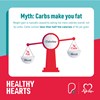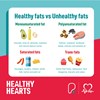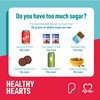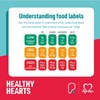Nutrition tips to keep your heart healthy

Eating a healthy, balanced diet is a simple way to help reduce your risk of developing heart and circulatory disease in a number of ways. But there is lots of conflicting information out there about what you should and shouldn’t eat to have a healthy diet.
In this week’s educational blog, we’re dispelling the myths so you can learn how the foods you eat can impact your risk of heart and circulatory disease. Plus, get top tips from the dietitian’s at the BHF on what foods you should be including and which you should be cutting back on to keep your heart healthy.
WHY IS LOOKING AFTER MY HEART HEALTH SO IMPORTANT?
The heart is the most important muscle in our body, as it keeps us alive. It does this by pumping blood containing oxygen and nutrients to our muscles, organs, and brain.
More impressively, it does this without us having to think about making our heart work – it just does! That’s because our heart is an involuntary muscle – it beats by itself using its own electrical system.
However, our heart will only work properly if we look after it. Some lifestyle choices such as little physical activity and eating unhealthily can all increase your risk of developing heart or circulatory disease.
The good news is there are lots of simple ways to look after your heart health and help it to get stronger and healthier – one being by eating a nutritious, balanced diet.
THE BENEFITS OF A HEALTHY BALANCED DIET
What you chose to put in your body can really affect how you feel, how well your immune system functions and how healthy you are.
While we firmly believe that no food is ever off limits, prioritising healthy, nutritious, micronutrient-rich foods in the right amounts is one of the best things you can do for your overall health, as well as your heart health.
With so much conflicting information out there about what you should and shouldn’t eat, it can be difficult to know what a healthy balanced diet should look like. Aim to include foods which are rich in vitamins and fibre (like fruits and vegetables), and include a mix of carbohydrates, protein, and healthy fats. Eating a healthy balanced diet like this can help to reduce your risk of developing heart and circulatory disease in a number of ways.
If you already have a heart or circulatory disease, eating better can also help to protect your heart from further problems.
HOW CAN I EAT A HEALTHY BALANCED DIET TO LOOK AFTER MY HEART?
Eating healthy doesn’t have to mean avoiding your favourite foods and eating nothing but vegetables. There are lots of small swaps and easy additions you can make to your diet to look after your heart health that won’t leave you feeling hungry and unsatisfied. Eating healthy doesn’t have to be complicated either – so don’t worry about spending lots of money or time making healthier meals.
So, what does eating healthier look like? We look at how to make gradual changes to your diet and what to look out for when reading food labels below, so you can make more informed and nutritious choices.
Fruit and vegetables
Fruit and vegetables are packed full of vitamins, minerals, and fibre, so are an easy way to add more health to your plate.
Aim to eat at least five portions of fruit and vegetables per day, filling your plate with plenty of colour to get a variety of different vitamins and minerals.
Don’t worry about everything having to be fresh! Frozen and tinned fruit (in juice) and vegetables (in water) are a great way to help reduce food waste and they still pack in all the important micronutrients (vitamins and minerals) to help your body and heart stay fit and healthy.
One of the easiest ways to meet the current guidelines is to try and add fruit and vegetables into your daily routine and meals as well as snacks. Why not try grated apple in your morning porridge, or chopped banana and peanut butter on wholemeal toast as a pre-workout fuel? Simple swaps will make sure you get all the benefits fruit and veg can offer!
Loading your plate with veg is also a great way to get more fibre in your diet. Not a fan of vegetables? Try cooking them in different ways like roasting them in a little bit of healthy fat or chop them up small and throw them into a sauce.
In addition to being great for your health, adding more veg helps to bulk out your meal, so you feel fuller for longer, which is useful for anyone who is trying to lose or manage their weight.
Carbohydrates
Although carbohydrates are often made out to be the enemy, there is no truth to the claims that carbs can make you fat. Weight gain is typically caused by eating too many calories, not by eating carbs. In fact, gram for gram, carbohydrates (4 kcals per gram) contain less than half the calories of fat (9 kcals per gram), and the same amount as protein (4 kcals per gram).

Carbs are your body’s main source of energy, which is why people who cut carbs can experience brain fog and fatigue. Not only are carbs important for fuelling your workouts, but wholegrain versions will also help to aid digestion too.
A healthy balanced diet should try to include a portion of high fibre starchy carbohydrates with every meal. This could be foods such as potatoes with the skins on, brown rice, wholewheat pasta, oats, or wholegrain bread. These carbohydrates have a higher fibre content, which helps with digestion, maintaining a healthy gut and keeping you feeling fuller for longer.
Protein
Protein is known as the building blocks of the body, as it helps your body (and muscles!) to grow, recover and repair.
The general population are recommended to consume 0.75g of protein per kg of body weight per day and most of us already meet or even exceed this with our typical diet. Those who are more active or are trying to build muscle may benefit from increasing their protein intake, but this is a great starting point!
In the UK, meat is one of the main sources of protein in our diet, but when it comes to heart health, some meats are better than others. That’s because some meats can be high in saturated fat and processed meats like ham, bacon and sausages can be high in salt as well.
Too much saturated fat is linked to raised cholesterol levels and too much salt is link to high blood pressure, both of which increase your risk of a heart attack or stroke.
The type of meat you choose and how you cook it can all make a difference. While it’s fine to have fattier meats occasionally, making the following swaps most of the time can help to benefit your heart health:
- Aim to have less than 70g per day of red and processed meat
- Choose leaner meats where possible – for example, try 5% fat beef mince instead of standard and skinless chicken breast is leaner than chicken thigh
- Cut back on consumption of processed meats such as sausages, bacon, and cured meats like salami
- When cooking, try to grill or roast meat instead of frying
- Cut the visible fat off meat like chops and steak and remove the skin from chicken
- Avoid adding extra fat or oil when cooking your meat
Opting for lean proteins like chicken breast or white fish, oily fish like salmon and mackerel, nuts and seeds, and plant-based proteins such as beans and lentils can help to reduce your risk of heart and circulatory disease.
Remember, lots of little changes add up. Make small swaps to your regular meals, and you’ll be more likely to stick to it. For example, if you’re making a chilli, why not try and swap out half of the minced beef for lentils and chopped veg rather than cutting it out completely.
Fats
Although you might have been told to avoid fats, the right kind of fats play a huge role in our overall health, including supporting our brain functioning, hormone production, satiety and absorption of fat-soluble vitamins A, D, E and K.

When looking after your heart health, it’s important to understand the different types of fat, and prioritise healthy sources of fat within your diet. That’s because eating too much of the wrong fats can increase your blood cholesterol levels which increases your risk of heart and circulatory disease.
- Monounsaturated and Polyunsaturated Fats
These types of fats are often referred to as ‘healthier fats’ and should be prioritised when trying to look after your heart health.
Unsaturated fats are often rich in Omega-3 and Omega-6 fatty acids, found in foods such as oily fish, ground flaxseed and walnuts. These types of fats are both classed as essential fatty acids (EFA), which we need to consume in our diet as our body can’t produce them naturally.
Eating unsaturated fats instead of saturated fats can improve your cholesterol levels, helping to look after your heart health.
- Saturated Fats and Trans Fats
These types of fats are referred to as ‘unhealthy fats’ and you should limit foods that contain this type of fat. This includes things like as processed meats, fried foods, biscuits, cakes, hard cheeses, cream, butter, and palm oil.
Eating too much saturated or trans-fat can increase your non-HDL cholesterol within your blood, which is known as ‘bad’ cholesterol. Having high cholesterol increases your risk of heart disease.
Aim to consume no more than 10% of your daily calories from saturated fats – that’s approximately 20g of saturated fat per day.
It’s also recommended that no more than 2% of your daily calories should come from trans fats, but intakes in the UK are generally well below this.
You might find it helpful to use a physical or digital food diary that helps you to keep track of how much saturated fat you are eating per day. You can check the saturated fat content in foods by checking the nutrition label, or some digital food diaries let you scan food barcodes to see the information too.
Fibre
Fibre is well known for being beneficial for digestion and keeping you fuller for longer, but did you know that it also helps to reduce your chance of getting high cholesterol by stopping bad cholesterol from getting into the bloodstream?
Eating foods high in soluble fibre can also help to lower your cholesterol levels. Good examples of soluble fibre are oats, kidney beans, lentils, and chickpeas.
It’s not just cholesterol that fibre improves either. It also helps to reduce your risk of heart and circulatory disease, strokes, and type 2 diabetes.
It’s recommended that you get 30g of fibre in your diet per day, but many of us don’t get enough! – on average in the UK were only eating about 18g! Try these simple ways to get more fibre in your diets:
- Keep the skin on fruit and vegetables
- Snack on a portion of nuts
- Swap white starchy foods likes bread, rice, breakfast cereals and pasta for wholegrain alternatives
- Include more beans and pulses in your diet
Sugar
Sugar is a type of carbohydrate, and it is found naturally in many foods such as milk and fruit. These foods play a role in a healthy diet because they also give us nutrients such as vitamins, minerals, protein, and fibre that our body needs.
However, many foods contain ‘free sugars’, and these are the types of sugar we need to cut down on. These types of sugars are added to foods such as sugary breakfast cereals, sugary drinks, biscuits, cakes, and flavoured yoghurts, or found naturally in honey, syrups, fruit juices and smoothies.

While there is no single food that can cause weight gain, it can be easy to overeat foods high in sugar like chocolate and sweets. These sorts of foods often don’t offer much in terms of nutrition other than the energy they provide.
Eating a diet that is high in free sugars is linked to a high energy diet and this can lead to weight gain. This increases your risk of developing heart and circulatory diseases, as well as risk factors like Type 2 diabetes and high blood pressure.
It’s recommended that we consume no more than 30g of free sugars every day, which is the equivalent of 7 cubes of sugar. But on average, UK adults eat nearly twice the recommended amount.
Try these small swaps to help cut back on your daily sugar intake:
- Try reducing the amount of sugar you add to your tea or coffee
- Swap sugary desserts and sweet treats for fruit instead
- Look for breakfast cereals without added sugar or honey
- Try plain yoghurt with fresh fruit instead of fruit yoghurt
- Swap full sugar drinks for diet and sugar-free alternatives
Salt
Eating too much salt can increase your risk of developing high blood pressure, which increases your risk of
Eating too much salt can increase your risk of developing high blood pressure, which increases your risk of heart and circulatory diseases.
Adults should eat no more than 6g of salt per day (2.4g sodium) which is only about one teaspoon! While this sounds a lot, many of us likely eat more than this without even realising. That’s because processed and pre-packaged foods often have added salt, so in addition to any salt you add after cooking, your meals and snacks may already be loaded with high salt levels.
A simple way to reduce your salt intake is to check the salt content in the everyday foods you buy and try to choose lower-salt options. You can do this by looking at the nutrition label, which often shows salt content as colour-coded: green (low), amber (medium) and red (high). Try to opt for green or amber foods, and only eat high-salt foods in small amounts.
If the nutrition label only shows sodium, you can work out the amount of salt in the product by multiplying the total sodium by 2.5. For example, 1g of sodium per 100g is 2.5g of salt per 100g.

Getting creative with cooking and swapping salt for various herbs and spices can also help you to lower your intake without compromising on flavour. Why not try adding things like garlic, rosemary, paprika, chilli, lemon, or coriander to your meals to help reduce your salt intake.
How do I know what portion size to eat?
One of the most common reasons for gaining weight is eating portions that are too large. Even if you eat a healthy balanced diet, if you eat too much, you’ll still gain weight.
Understanding portion sizes is an effective way to manage your weight, and even get the right balance of foods within your diet. Check out this handy guide to portions below:

Understanding food labels
Packaged food often has nutritional information labelling on the back of packs which shows the carbohydrate, fat, protein, fibre, salt, and sugar content of that food.
Many foods will also have a colour-coded nutritional label on the front of the pack which shows at a glance whether the food is low (green), medium (orange) or red (high) in fat, saturated fat, sugar and salt per 100g.
Using this as a reference when shopping can be helpful to make healthier food choices. Below is a handy guide you can use to understand food labels:

How to make healthier choices when eating out
If you’re only eating out occasionally or it’s a special occasion, it’s fine to enjoy foods that may not be as nutritious. However, there will be times when you want to try and make a more balanced choice. Unfortunately, it can be difficult to decide what to eat when you can’t see the nutritional information or how your food is being made.
Here are some quick tips for making healthy choices when eating out:
- Reduce how often you eat in fast-food restaurants as the food can be high in salt, fat, and sugar.
- Opt for chicken or fish instead of fatty red or processed meats like sausages, bacon, and burgers.
- When eating pasta, try to avoid creamy or cheesy sauces as these often are high in saturated fat and salt. Instead, look for a tomato or vegetable-based sauce.
- Try to avoid fried food, and instead look for foods that have been baked, steamed, or grilled.
- If your meal comes in different sizes, try a smaller portion, and add a side of vegetables or salad too.
Tips to keeping healthy eating costs down
Eating healthy doesn’t have to cost the world. There are lots of ways to keep costs down and make tasty, budget friendly meals. Here are some of our top tips:
- Cut food waste by using some frozen fruit and vegetables instead of fresh. They still have all the important vitamins and minerals but are often cheaper and don’t go off as quickly
- Bulk buy food (it’s often cheaper) and then freeze individual portions
- Try supermarket own-brand foods, often you’re paying for the brand name for a very similar product
- Try to buy seasonal fruit and vegetables, as they are often cheaper than out of season alternatives
- Add vegetables, beans, and pulses to your meals to add bulk and help them go further
- Aim to do your food shopping after you’ve eaten, so that you’re less likely to go for unhealthy foods
Want to learn more?
We also have lots of helpful tips and bitesize information on our blog and social channels to help you improve your heart health.
Interested in finding out more about heart health? Check out our blog on how to look after your heart and read our simple swaps and manageable steps you can take to reduce your risk of heart and circulatory disease.
Want to know more about how your heart works? We’ve got you covered too. Check out our blog on how your heart works and learn the basics about your hearts anatomy and how it keeps you alive.
To find out more about our partnership with the British Heart Foundation and more helpful resources and information, click here.